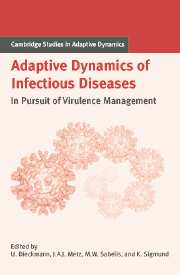Book contents
- Frontmatter
- Contents
- Contributing Authors
- List of Boxes
- Notational Standards
- 1 Introduction
- A Setting the Stage
- B Host Population Structure
- Introduction to Part B
- 6 Variation in Susceptibility: Lessons from an Insect Virus
- 7 Contact Networks and the Evolution of Virulence
- 8 Virulence on the Edge: A Source–Sink Perspective
- C Within-Host Interactions
- D Pathogen–Host Coevolution
- E Multilevel Selection
- F Vaccines and Drugs
- G Perspectives for Virulence Management
- References
- Index
- International Institute for Applied Systems Analysis
8 - Virulence on the Edge: A Source–Sink Perspective
Published online by Cambridge University Press: 15 January 2010
- Frontmatter
- Contents
- Contributing Authors
- List of Boxes
- Notational Standards
- 1 Introduction
- A Setting the Stage
- B Host Population Structure
- Introduction to Part B
- 6 Variation in Susceptibility: Lessons from an Insect Virus
- 7 Contact Networks and the Evolution of Virulence
- 8 Virulence on the Edge: A Source–Sink Perspective
- C Within-Host Interactions
- D Pathogen–Host Coevolution
- E Multilevel Selection
- F Vaccines and Drugs
- G Perspectives for Virulence Management
- References
- Index
- International Institute for Applied Systems Analysis
Summary
Introduction
A recognition of spatial processes can be found even in the earliest glimmerings of intellectual understanding of the parasitic origin of infectious disease. As described in Ewald (1994a, p. 184), the Renaissance thinker Girolamo Fracastoro hypothesized that disease-specific germs could multiply within a person's body and be transmitted either directly over short distances, or over long distances (e.g., via contaminated objects). In recent years, a number of authors have emphasized how many epidemiological phenomena cannot be understood without explicitly considering infectious processes in a spatial context (e.g., Holmes 1997). There are several general issues that arise automatically when spatial aspects of the dynamics of infectious disease are considered. For instance, if infections are localized, spatial separation increases the degrees of freedom of a host–parasite system, permitting a rich array of dynamical behaviors to arise even in a spatially homogeneous world (e.g., Hassell et al. 1994). Moreover, spatial heterogeneity is the norm rather than the exception in ecological systems (Williamson 1981). Dispersal often couples habitats that differ strongly in local population parameters (e.g., carrying capacity), or involve anisotropic spatial flows. This leads to the potential for asymmetries among habitats in the degree of the impact of spatial coupling on local ecological and evolutionary dynamics.
In population ecology, an example of such asymmetries that has received considerable attention in recent years is “source–sink” dynamics.
- Type
- Chapter
- Information
- Adaptive Dynamics of Infectious DiseasesIn Pursuit of Virulence Management, pp. 104 - 120Publisher: Cambridge University PressPrint publication year: 2002
- 8
- Cited by

